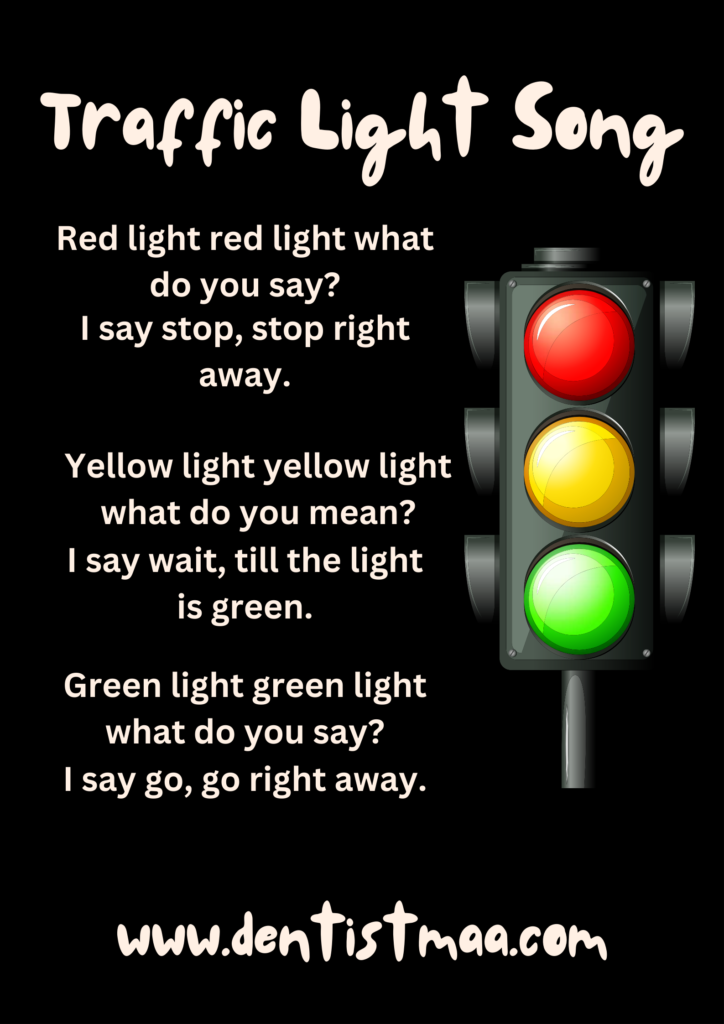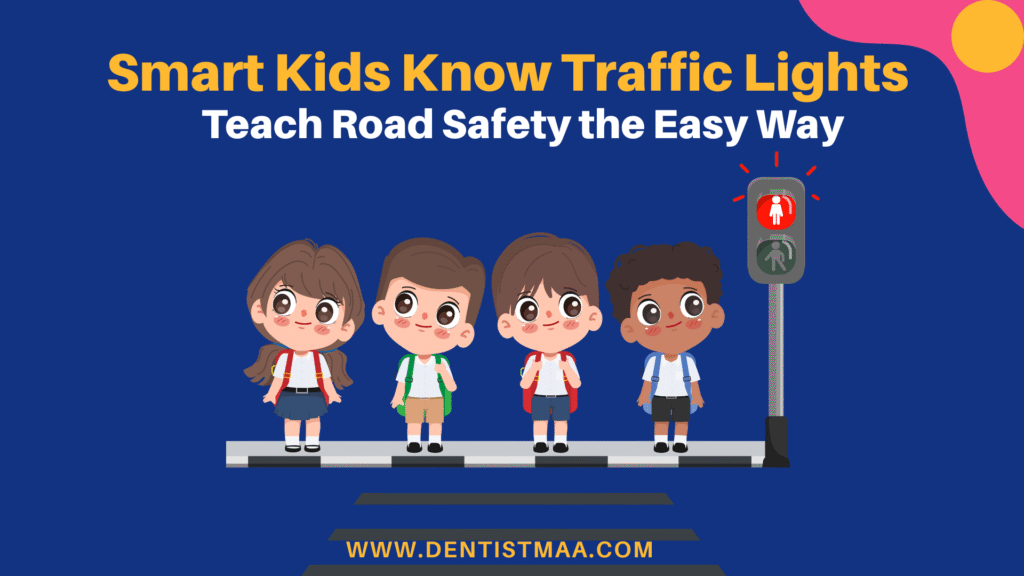Do we as parents follow the traffic lights and the road safety rules? A lot of the time, I see parents with kids not following the laws themselves. If we are not following them, how will the children follow??
Parents outside schools are seen parking on the zebra crossing, jumping red lights, throwing trash on the road, or even letting their kids stand out of the sunroofs. How is this safe and justified? How will we teach our kids the safety rules if we don’t follow them? Don’t we love our children enough to keep them safe? If we do love them, why don’t we follow the rules??
The traffic rules by the authorities are for our safety after all. Why do we need someone to tell us this??
Teaching children about traffic lights is one of the first steps in helping them understand road safety. These colourful signals are everywhere, in smart cities at crossings, intersections, and even in school books. But do our children know what they mean and how to respond to them?
In this blog post, we will explore the meaning of traffic lights, how to explain traffic signals to children in a fun and simple way, and share easy tips and activities for parents to make learning enjoyable.
What Are Traffic Lights?
Traffic lights are special lights used to control the flow of traffic. They are mostly found at road intersections and crossings. They tell vehicles and pedestrians when to stop and when to go, helping everyone stay safe.
Each traffic light has three main colours:
- Red
- Yellow (or Amber)
- Green
These colours are not just for drivers, they’re also important for walkers and especially children who cross the street.
Meaning of Each Traffic Light Colour
Understanding what each colour means is important for children:
1. Red Light – Stop 🛑🖐
- Red means STOP.
- When the red light is on, vehicles must stop.
- Pedestrians should not cross the road at the pedestrian red light.
How to explain to children:
Red means danger or stop. So, when we see the red light, we should immediately stop, and let the other side with the green light cross. If everyone starts moving together, there will be chaos and accidents. It is not safe. How much ever hurry you are in you need to stop at the red light.
2. Yellow Light – Wait 🟡
- Yellow means slow down or get ready to stop.
- It warns that the light is about to turn red.
- Pedestrians should not start crossing when the yellow light is flashing.
How to explain to children:
Yellow means wait or get ready. Just like you pause in a game before your turn, cars slow down when they see yellow. This is the gap given before the other side’s light turns green. So, do not cross at the yellow light, and wait for your light to turn green again.
3. Green Light – Go 🟢👍
- Green means GO.
- Vehicles can move forward.
- Pedestrians can cross the road (if it’s their turn).
How to explain to children:
Green is the signal to go! But always look both ways before stepping onto the road, as not everyone follows the traffic signals (which is not the right thing to do).
Why Are Traffic Signals Important?
Traffic signals play a big role in preventing accidents. Here’s why they matter:
- They organise traffic and reduce chaos.
- They help pedestrians cross safely.
- They guide drivers on when to stop and go.
- They save lives by reducing the risk of crashes.
When children understand this, they become more aware and responsible near roads.
How to Teach Traffic Lights to Children: Fun Tips and Ideas
Here are some easy and fun ways you can teach the concept of traffic lights and traffic signals to your child:
1. Use Real-Life Examples
Take your child for a walk and stop near a traffic signal. Show them how vehicles and people follow the lights. Ask simple questions like:
- “What colour is the light now?”
- “What should the cars do?”
- “Can we cross now?”
This is a practical demonstration which will help in easy understanding and following the signs. This is one of the best ways to teach kids about traffic lights.
2. Traffic Light Song or Poem
Red light, red light, what do you say?
I say STOP and stop right away.Yellow light, yellow light, what do you mean?
I say WAIT, till the light is green.Green light, green light, what do you say?
I say GO, go Right Away!

3. Crafts and Drawing
Let your child draw a traffic light and colour it. You can also make a small model using cardboard and colored paper. Ask them to explain each colour as they stick it on.
4. Role-Playing Games
Set up a mini road at home using toy cars and blocks. Let your child act as the traffic light controller or a pedestrian. This helps them learn by doing. You can also pretend to make a mini car with chairs, and one parent can signal the traffic light. The child can be the driver and pretend to drive, and decide when to stop. This is again a great way of learning. Kids learn a lot through pretend play.
5. Story Time
Tell short stories where traffic signals play a role. For example, “Little Riya waited for the green signal before crossing the road like a smart girl.”
Safety Rules to Teach Along With Traffic Lights
Besides knowing the meaning of traffic lights, children must learn basic road safety rules:
- Always hold an adult’s hand when crossing the road.
- Cross only at the zebra crossings.
- Look left, right, then left again before crossing the road.
- Never run across the road.
- Don’t play near traffic or on the road.
Reinforce these rules regularly during walks.
FAQs: Traffic Lights for Children
Q1. At what age should I start teaching my child about traffic lights?
You can start as early as 3–4 years old using songs, stories, and visuals. Make it fun and age-appropriate. My daughter started learning at 3, and she follows all the rules. She understands they are for her safety. The earlier the child is taught something, the better the child understands and retains it.
Q2. What if my child gets confused between red and green?
That’s common! Use consistent examples and everyday practice. You can also label colours on toys or flashcards. Be there with your child on the road, even if the child has understood all the lights and signals. Don’t leave them alone, at least till they turn 10.
Q3. Are pedestrian signals different from traffic lights?
Yes, pedestrian signals often show walking figures. A green man means it’s safe to walk, a red man means stop. Teach your child to recognise both.
Q4. How can I make my child remember traffic rules better?
Repetition and fun activities work best. Include small quizzes during walks like “What colour is the signal? What should we do?” Pretend play works wonders.
Q5. Is it necessary for children to learn about traffic signals if they don’t walk alone?
Yes. Even if they are with an adult, it’s good to build awareness. One day, they’ll walk or cycle independently, and this knowledge will keep them safe. The earlier the better.
Related: 7 Practical and Effective Tips to Encourage Independence in Your Child
Final Thoughts
Teaching children the meaning of traffic lights is a simple yet powerful way to start early lessons on safety and responsibility. Through regular conversations, creative activities, and everyday examples, your child can become confident and aware of the roads.
Always remember, learning about traffic signals isn’t just about colours. It’s about learning to pause, observe, and make safe choices. And that’s a life skill every child deserves to master. It is for the safety of not just your child but the fellow passengers too.
If you found this post helpful, don’t forget to share it with other parents! Let’s raise road-smart kids together. 🚦👧👦




